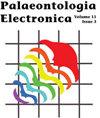求助PDF
{"title":"A multicarpellate fruit from Late Cretaceous sediments of South Bohemia, Czech Republic","authors":"Z. Hermanova, J. Čepičková, J. Kvaček, M. von Balthazar, J. Schönenberger","doi":"10.26879/1192","DOIUrl":null,"url":null,"abstract":"The gynoecium of most angiosperms consists of two or more united carpels and syncarpy is generally considered a key innovation. Multicarpellate-syncarpous gynoe-cia, i.e., with more than five united carpels, are overall rare, probably because of developmental and functional constraints. Based on scanning electron microscopy (SEM) and X-ray computed tomography (microCT), we here describe a new fossil taxon, Covidifructus multicarpellatus, from the Late Cretaceous (Late Turonian-Santonian) of Southern Bohemia (Czech Republic). The new fossil taxon is based on a single syn-carpous gynoecium (an immature fruit) consisting of 10 carpels, each containing a single seed;no other floral organs are preserved. The gynoecium morphology of C. multicarpellatus is highly complex and involves an enclosed, undifferentiated floral apex, an empty space in the centre of the ovary formed by the postgenital union of the distal parts of the carpels, an irregular apical closure of the ovary, and possibly an extra-gynoecial compitum. Similar gynoecium morphologies have evolved conver-gently in various angiosperm lineages and are directly linked with the special developmental (architectural) challenges of forming a functional syncarpous gynoecium with many carpels. Among extant angiosperms, C. multicarpellatus is most similar to Dille-nia (Dilleniaceae). However, a systematic assignment based on gynoecium characters alone would involve a high level of uncertainty, even if the gynoecial features of C. mul-ticarpellatus are rare among other angiosperms. © 2022, Texas A and M University. All rights reserved.","PeriodicalId":56100,"journal":{"name":"Palaeontologia Electronica","volume":"1 1","pages":""},"PeriodicalIF":2.0000,"publicationDate":"2022-01-01","publicationTypes":"Journal Article","fieldsOfStudy":null,"isOpenAccess":false,"openAccessPdf":"","citationCount":"0","resultStr":null,"platform":"Semanticscholar","paperid":null,"PeriodicalName":"Palaeontologia Electronica","FirstCategoryId":"89","ListUrlMain":"https://doi.org/10.26879/1192","RegionNum":4,"RegionCategory":"地球科学","ArticlePicture":[],"TitleCN":null,"AbstractTextCN":null,"PMCID":null,"EPubDate":"","PubModel":"","JCR":"Q1","JCRName":"Earth and Planetary Sciences","Score":null,"Total":0}
引用次数: 0
引用
批量引用
捷克共和国南波西米亚晚白垩世沉积物中的多皮果
大多数被子植物的雌蕊由两个或两个以上的心皮组成,合心通常被认为是一个关键的创新。可能由于发育和功能的限制,具有5个以上心皮的多心皮合生雌心瓣总体上是罕见的。基于扫描电子显微镜(SEM)和x射线计算机断层扫描(microCT),我们描述了来自捷克南部波西米亚晚白垩世(晚Turonian-Santonian)的一个新的化石分类群Covidifructus multicarpellatus。新的化石分类群是基于一个单一的同心皮雌蕊(一种未成熟的果实),由10个心皮组成,每个心皮含有一个种子;没有其他的花器官被保存下来。多皮草雌蕊的形态非常复杂,包括一个封闭的、未分化的花尖,一个由心皮远端部分生殖后结合形成的子房中心的空白空间,一个不规则的子房顶端闭合,可能还有一个雌蕊外的合心器。在不同的被子植物谱系中,相似的雌蕊形态发生了进化,并与形成具有许多心皮的功能性合掌雌蕊的特殊发育(结构)挑战直接相关。在现存被子植物中,多皮草与龙葵科的龙葵最为相似。然而,单根据雌蕊特征进行系统的分配将会有很高的不确定性,即使在其他被子植物中,多皮蕨的雌蕊特征是罕见的。©2022,Texas A and M University。版权所有。
本文章由计算机程序翻译,如有差异,请以英文原文为准。


